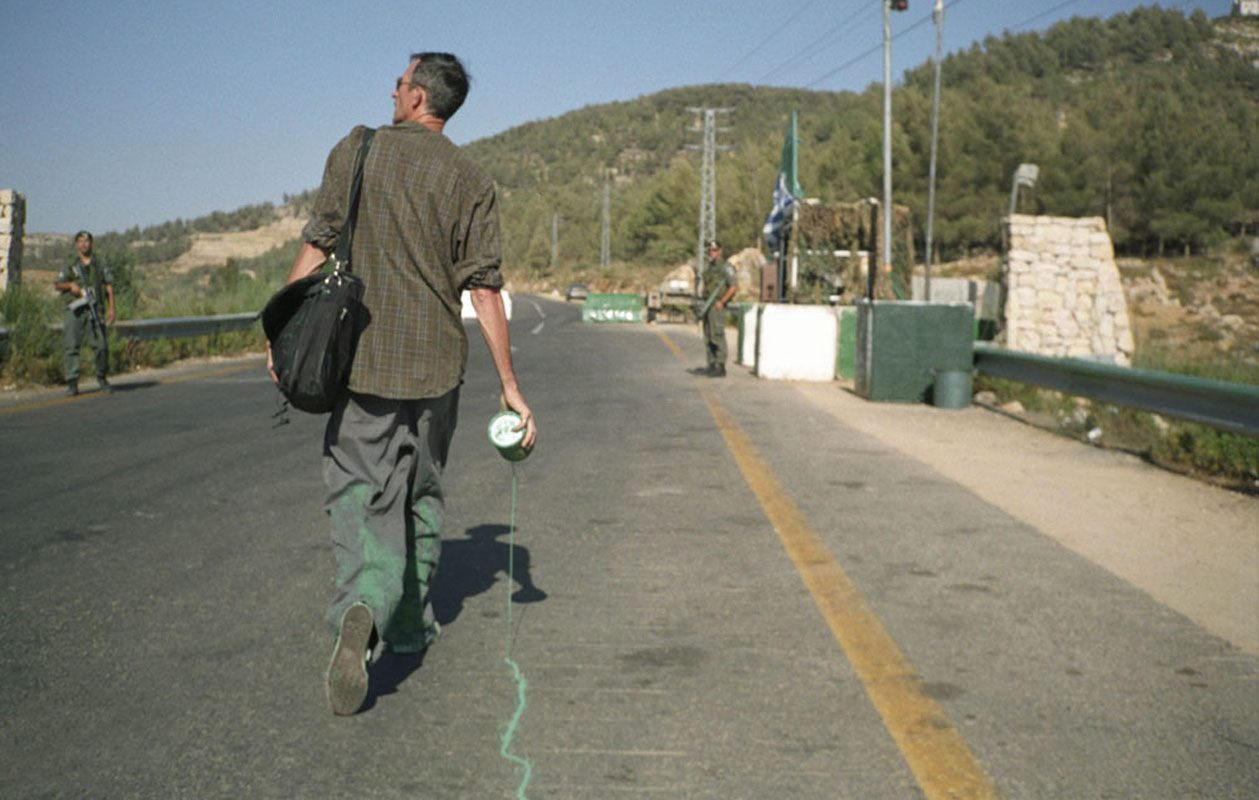To coincide with the current exhibition The Family in Disorder: Truth or Dare by Cinthia Marcelle, on Saturday 28 April Modern Art Oxford will screen the acclaimed documentary video When Faith Moves Mountains by Francis Alÿs (b. 1959, Antwerp, Belgium. Lives and works Mexico City).
In this post Modern Art Oxford’s Assistant Curator, Jonathan Weston introduces Francis Alÿs’ socio-political practice, describing key works and the various locations which provoked his artistic interventions.
–
Francis Alÿs’ artistic practice combines the everyday sphere with fables and allegories he adopts as starting points for his works and actions. Since leaving Belgium for his adopted home of Mexico City in February 1986, Alÿs has adapted, observed and reflected on the socio-political situations of the many countries he has worked in.
A persistent narrative within Alÿs’ interventions in the public sphere is his direct engagement with various localities across the world and the people who occupy these places. By doing so, Alÿs provides a platform for these poetic moments of reflection and asks us as viewers to experience ideas and imagery from which we may be geographically removed, but that also resonates with us. With the rapidly expanding pace of life it is important to slow down and appreciate how we interact with our environment and the people around us. It’s easy to become desensitised to our surroundings and take for granted the situations in which we are constantly surrounded. Alÿs works to address these situations by focusing his lens on marginalised issues and projecting them into view, whether that is reclaiming land and identity through community effort (When Faith Moves Mountains, 2002) or highlighting the plight of rough sleepers in Mexico City (Sleepers, 1999–present). These associations are as important and prevalent now as ever before, as we endeavour to take collective responsibility for our actions and their impact on our environments.
Alÿs’ interventions start life as ideas that manifest through sketches, paintings and notes, before being realised as fleeting moments of quiet transformation in the public spaces we collectively inhabit. These subtle actions – be it placing pillows in broken windows (Placing Pillows, 1990) or forming a green line through the city with a leaking can of paint (The Green Line, 2004) – challenge and elevate the very fabric of the spaces we occupy on a daily basis, altering both physically and spiritually their pre-existing architecture and associations.

The word ‘occupy’ has a duel meaning: referring both to the personal spaces in which we live, work and settle, and the act of taking land by force. It is fitting that Alÿs’ actions encompass both of these distinctive meanings, as is the case with his video documentary of When Faith Moves Mountains (2002). During a previous visit to Lima, Peru in October 2000 (during the last three months of the Fujimori dictatorship) Alÿs was struck by the inescapable political context and social tension palpable on the streets. The artist’s response to this striking encounter materialised as a collective act of poetic redress when 500 volunteers took to a desolate landscape just outside the Peruvian capital Lima in a show of unity and defiance. Together they moved a sand dune by several inches in an attempt to change the dynamics of their land in the face of considerable counter force and heavily outweighed odds. Alÿs described the resulting outcome as a social allegory: the literal moving of the sand dune and the symbolic difficulty of individually and collectively making an impact against political power and legislation.

Within his artistic practice Alÿs regularly assumes the role of tourist or outsider, allowing himself the freedom to navigate the streets and command the attention of spectators who become unwitting participants in his works. In this sense Alÿs conducts the unfolding action in search of a predetermined outcome, be that drawing a crowd to look up at the sky simply by starting the act (Looking Up, 2001) or encouraging a pack of stray dogs to attack the camera by breaking through a narrow pathway into a village guarded by dogs (Gringo, 2003). The role of director is most clearly assumed in the work Re-Enactments (2000) in which Alÿs plays out the same action twice: buying a 9 mm Beretta from a gun store in Mexico City and walking down the street holding the gun until stopped with force by the police. In the first video Alÿs documented the actual lived event while the second was a precise reconstruction performed by actors with the specific aim to produce the same outcome. By producing the two videos and showing them side-by-side Alÿs aimed to ‘question the rapport we have today with film and photo, and how media can distort and dramatise the immediate reality of the moment’. These questions of authenticity and recreation have historically been a contested critical area of live performance, it’s documentation and restaging.

Words by Jonathan Weston, Assistant Curator at Modern Art Oxford
Francis Alÿs: When Faith Moves Mountains (Making of), will be on view at Modern Art Oxford on Saturday 28 April 2018. Read more about the screening here.
